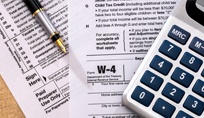The Tax Cuts and Jobs Act (TCJA) significantly changed the U.S. tax code. As a result of TCJA, the new tax withholding tables, which tell employers how much to withhold from employee’s paychecks, were issued to incorporate the changes. In the first year, the IRS probably had employers not withhold enough from employees, as the Administration wanted taxpayers to see an increase in their paychecks throughout the year, due to the tax law change. Many taxpayers probably did not really notice the increase, but they did notice getting less of a refund, or owing money when they filed their 2018 tax returns. Unknowingly, many taxpayers did not have enough money withheld from their wages, which is why they received less of a refund or owed money.
All taxpayers should review their withholdings to make sure that they are paying in enough. The IRS has a Tax Withholding Estimator that they recommend all taxpayers use. The IRS has been promoting their estimator and the new Form W-4, Employee’s Withholding Certificate, so that taxpayers do not have the same unexpected surprises when they file their 2019 tax returns.

Check Your Withholding
IRS Paycheck Checkup – Taxpayers should use the IRS Tax Withholding Estimator to perform a Paycheck Checkup and adjust their withholdings by filing a new Form W-4 with their employer, if needed.
Many tax professionals have been working with their clients to make sure their withholding for the year is enough to cover their expected tax liability. Taxpayers can also make quarterly estimated tax payments to cover the payment of additional tax expected to be owed.
Check your annual withholding using the IRS Tax Withholding Estimator or checking in with your tax professional.
Some places to find Tax Professionals

